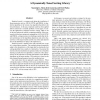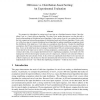4315 search results - page 27 / 863 » Sorting in linear time |
ITNG
2007
IEEE
14 years 1 months ago
2007
IEEE
A block-interchange is a rearrangement event that exchanges two, not necessarily consecutive, contiguous regions in a genome, maintaining the original orientation. Signed reversal...
CORR
2012
Springer
12 years 3 months ago
2012
Springer
erate (Extended Abstract) Patrick Bindjeme1† and James Allen Fill1 1 Department of Applied Mathematics and Statistics, The Johns Hopkins University, 34th and Charles Streets, Bal...
CGO
2004
IEEE
13 years 11 months ago
2004
IEEE
Empirical search is a strategy used during the installation of library generators such as ATLAS, FFTW, and SPIRAL to identify the algorithm or the version of an algorithm that del...
ACL
2006
13 years 9 months ago
2006
Synchronous Context-Free Grammars (SCFGs) have been successfully exploited as translation models in machine translation applications. When parsing with an SCFG, computational comp...
ESA
2005
Springer
14 years 1 months ago
2005
Springer
We compare two algorithms for sorting out-of-core data on a distributed-memory cluster. One algorithm, Csort, is a 3-pass oblivious algorithm. The other, Dsort, makes three passes...


